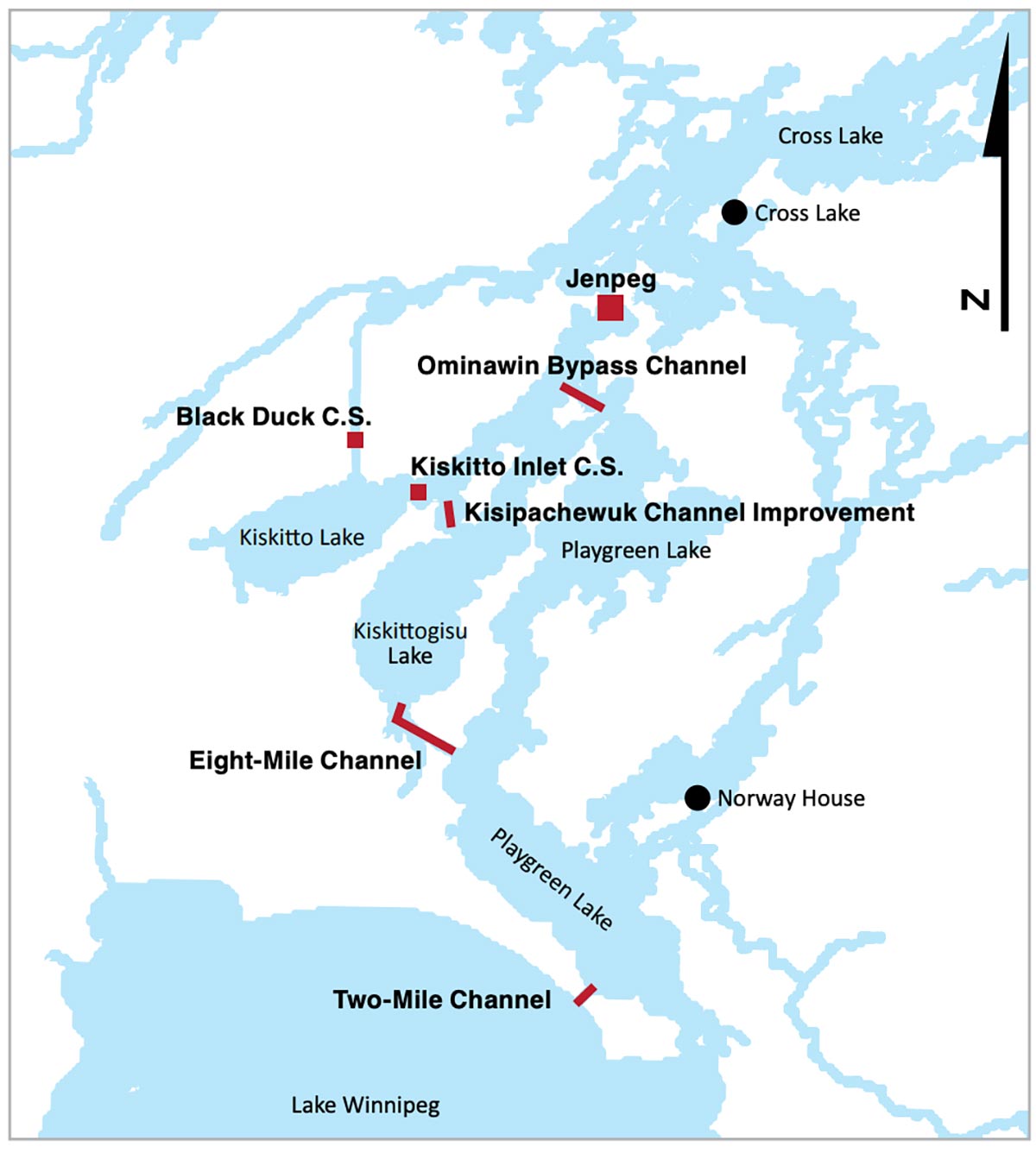Working with the flow – Lake Winnipeg Regulation
Lake Winnipeg in Manitoba is the 10th largest freshwater lake in the world – covering 9,650 square miles – and it’s surrounded by miles of sandy white beaches. It also is the dependable source of water for the generation of hydroelectric power for all of Manitoba Hydro’s customers.
Historically, Lake Winnipeg regularly flooded when inflows surpassed the limited outflow capacity at the north end of the lake. This began to change in 1970 when the Province of Manitoba announced its decision to regulate outflows from the lake and the Province granted Manitoba Hydro an interim Water Power Act Licence to assume responsibility for the outflow of Lake Winnipeg.

Regulating Lake Winnipeg’s outflow through the west channel of the Nelson River, Jenpeg is a key component of the Lake Winnipeg Regulation system designed to enhance outflow and reduce shoreline flooding on Lake Winnipeg.
Construction of the Lake Winnipeg Regulation project was completed in 1976 and included excavated channels at the north end of the lake to increase the natural outflow capacity and a control structure to regulate the outflow.
Increasing the outflow capacity provides flood relief to the lake and allows Manitoba Hydro to maximize production of electricity by generating stations on the Nelson River. Combined, these stations are responsible for approximately 80 per cent of the electricity generated in Manitoba.
The Lake Winnipeg Regulation project was not built with the intent to hold water in Lake Winnipeg – rather, it was designed to move more water out, helping to reduce flood risk around the lake and ensuring reliable water flow for electricity throughout the year.
Due to the seasonal diversity of energy demand between Manitoba Hydro’s customers in the U.S. and at home, the regulated flow of water means a uniform supply of power is generated throughout the year, meeting peak demand for energy whenever it is needed: typically, in the winter for Manitoba and in the summer for Manitoba Hydro’s export customers in the U.S.
Dale Hutchison, Manitoba Hydro Section Head for Waterways Community Engagement, describes the Lake Winnipeg Regulation project as having multiple benefits.
“Lake Winnipeg Regulation has two purposes,” Hutchison said. “One is to provide flood relief around Lake Winnipeg. The other is to provide water to our major generating stations along the Nelson River as we need it to meet energy demands.”
The lake flows north with more than a dozen rivers feeding into it and only one — the Nelson River— draining it towards Hudson Bay.

This map illustrates the locations of the facilities, channels and other bodies involved in Lake Winnipeg regulation. See the section marked “Measures for the control of water at the north end of Lake Winnipeg” below for more information.
Warren Landing is Lake Winnipeg’s only natural outlet. It’s shallow and wide —15 feet deep on average and two miles wide. In winter, ice on the lake gets several feet thick restricting the water flow underneath.
“During a wet year you could get a lot of water flowing into the lake over the spring, summer and fall,” Hutchison said. “Ice build-up over the winter restricts water flow out of the lake, so coming into the following spring the lake is still high. Then, if you had another year with a lot of water, the lake would keep going up until you got all this flooding around the lake – this type of flooding happened about every decade.
“You can also imagine if you’re trying to build generating stations downstream, not being able to get the water out of the lake is a pretty big limit. You’re not getting the water you need when you need it.
“Lake Winnipeg Regulation involved creating a second outflow for Lake Winnipeg to help move the water out of the lake as well as a control structure called Jenpeg on the main branch of the Nelson River to regulate the volume of water flowing out of the lake.”
By 1976, Manitoba Hydro had constructed this second outlet known as 2-Mile Channel (the primary outflow channel from Lake Winnipeg) and several other channels that aid with outflow.
Located approximately six miles northwest of Warren Landing, 2-Mile Channel helps flow water out of the lake more dependably. 2-Mile Channel is a narrower and deeper channel than Warren Landing and is designed to be less affected by winter ice.
“What [building that channel] meant is we could put more investments into generating facilities on the Nelson River, because it meant we had a reliable and consistent supply of water,” Hutchison said.
Speaking of reliability…
“We’re blessed with the geography of the land – water from four U.S. states and four Canadian provinces flow into Lake Winnipeg,” Dale says. “Even though you might have drought in the west, or drought in the east, it would be pretty rare for there to be drought in that whole area, so you’re almost always assured to get some water from the watershed coming into Lake Winnipeg.”
Lake Winnipeg Regulation helps relieve the threat of flooding to the people living around the lake, while helping to create a ready and consistent supply of water to supply the generation that will meet the energy requirements of all who need it.
Lake Winnipeg Water Regulation: the fine print
In 1970, Manitoba Hydro was granted an interim license to regulate outflow on Lake Winnipeg. As part of the license, Manitoba Hydro is able to set outflows from the lake at Jenpeg when the water level of the lake is between 711 and 715 feet above sea level. If the water level of the lake dips below 711 feet, Manitoba Hydro must operate Jenpeg, the lake’s control structure, as ordered by the Minister of Conservation & Climate. If the lake level exceeds 715 feet, Manitoba Hydro must discharge the excess water to reduce it to 715 feet.
* Agriculture and Resource Development | Province of Manitoba (gov.mb.ca).
